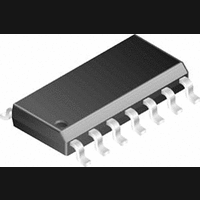LM2574HVM-ADJ National Semiconductor, LM2574HVM-ADJ Datasheet - Page 17

LM2574HVM-ADJ
Manufacturer Part Number
LM2574HVM-ADJ
Description
DC/DC Converter IC
Manufacturer
National Semiconductor
Datasheet
1.LM2574HVM-ADJ.pdf
(24 pages)
Specifications of LM2574HVM-ADJ
Input Voltage
60V
Output Current
500mA
Output Voltage
57V
No. Of Pins
14
Peak Reflow Compatible (260 C)
No
Supply Voltage Max
60V
Leaded Process Compatible
No
Mounting Type
Surface Mount
Lead Free Status / RoHS Status
Contains lead / RoHS non-compliant
Available stocks
Company
Part Number
Manufacturer
Quantity
Price
Company:
Part Number:
LM2574HVM-ADJ
Manufacturer:
NS
Quantity:
1 210
Application Hints
INDUCTOR RIPPLE CURRENT
When the switcher is operating in the continuous mode, the
inductor current waveform ranges from a triangular to a saw-
tooth type of waveform (depending on the input voltage). For
a given input voltage and output voltage, the peak-to-peak
amplitude of this inductor current waveform remains con-
stant. As the load current rises or falls, the entire sawtooth
current waveform also rises or falls. The average DC value
of this waveform is equal to the DC load current (in the buck
regulator configuration).
If the load current drops to a low enough level, the bottom of
the sawtooth current waveform will reach zero, and the
switcher will change to a discontinuous mode of operation.
This is a perfectly acceptable mode of operation. Any buck
switching regulator (no matter how large the inductor value
is) will be forced to run discontinuous if the load current is
light enough.
The curve shown in Figure 10 illustrates how the peak-to-
peak inductor ripple current ( I
different maximum load currents are selected, and also how
it changes as the operating point varies from the upper bor-
der to the lower border within an inductance region (see In-
ductor Selection guides).
Consider the following example:
The selection guide in Figure 5 shows that for a 0.4A load
current, and an input voltage range between 10V and 20V,
the inductance region selected by the guide is 330 µH. This
value of inductance will allow a peak-to-peak inductor ripple
current ( I
mum load current. For this inductor value, the I
vary depending on the input voltage. As the input voltage in-
creases to 20V, it approaches the upper border of the induc-
tance region, and the inductor ripple current increases. Re-
ferring to the curve in Figure 10 , it can be seen that at the
0.4A load current level, and operating near the upper border
of the 330 µH inductance region, the I
0.4A, or 212 mA p-p.
This I
inductor current rating can be determined, the minimum load
current required before the circuit goes to discontinuous op-
eration, and also, knowing the ESR of the output capacitor,
V
V
FIGURE 10. Inductor Ripple Current ( I
Based on Selection Guides from Figure 4 through
OUT
IN
= 10V minimum up to 20V maximum
IND
= 5V
IND
is important because from this number the peak
) to flow that will be a percentage of the maxi-
@
0.4A
Figure 8 .
(Continued)
IND
) is allowed to change as
IND
will be 53% of
IND
DS011394-18
IND
) Range
will also
17
the output ripple voltage can be calculated, or conversely,
measuring the output ripple voltage and knowing the I
the ESR can be calculated.
From the previous example, the Peak-to-peak Inductor
Ripple Current ( I
known, the following three formulas can be used to calculate
additional information about the switching regulator circuit:
1. Peak Inductor or peak switch current
2. Minimum load current before the circuit becomes dis-
3. Output Ripple Voltage = ( I
The selection guide chooses inductor values suitable for
continuous mode operation, but if the inductor value chosen
is prohibitively high, the designer should investigate the pos-
sibility of discontinuous operation. The computer design soft-
ware Switchers Made Simple will provide all component
values for discontinuous (as well as continuous) mode of op-
eration.
Inductors are available in different styles such as pot core,
toroid, E-frame, bobbin core, etc., as well as different core
materials, such as ferrites and powdered iron. The least ex-
pensive, the bobbin core type, consists of wire wrapped on a
ferrite rod core. This type of construction makes for an inex-
pensive inductor, but since the magnetic flux is not com-
pletely contained within the core, it generates more electro-
magnetic interference (EMI). This EMl can cause problems
in sensitive circuits, or can give incorrect scope readings be-
cause of induced voltages in the scope probe.
The inductors listed in the selection chart include powdered
iron toroid for Pulse Engineering, and ferrite bobbin core for
Renco.
An inductor should not be operated beyond its maximum
rated current because it may saturate. When an inductor be-
gins to saturate, the inductance decreases rapidly and the
inductor begins to look mainly resistive (the DC resistance of
the winding). This can cause the inductor current to rise very
rapidly and will affect the energy storage capabilities of the
inductor and could cause inductor overheating. Different in-
ductor types have different saturation characteristics, and
this should be kept in mind when selecting an inductor. The
inductor manufacturers’ data sheets include current and en-
ergy limits to avoid inductor saturation.
OUTPUT CAPACITOR
An output capacitor is required to filter the output voltage and
is needed for loop stability. The capacitor should be located
near the LM2574 using short pc board traces. Standard alu-
minum electrolytics are usually adequate, but low ESR types
are recommended for low output ripple voltage and good
stability. The ESR of a capacitor depends on many factors,
some which are: the value, the voltage rating, physical size
and the type of construction. In general, low value or low
voltage (less than 12V) electrolytic capacitors usually have
higher ESR numbers.
The amount of output ripple voltage is primarily a function of
the ESR (Equivalent Series Resistance) of the output ca-
continuous
IND
) = 212 mA p-p. Once the
IND
) x (ESR of C
www.national.com
IND
OUT
value is
)
IND
,











